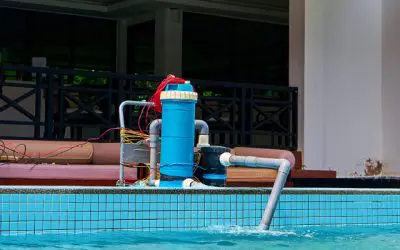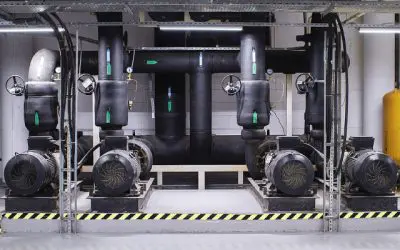
Pump performance curves are essential tools for anyone involved in the selection, operation, or maintenance of pumps. These curves provide a graphical representation of a pump’s performance under various operating conditions, helping engineers and operators make informed decisions about pump suitability and optimisation. In this blog, we’ll break down the key elements of a pump performance curve using the EUROFLO EU65/20 MBC pump as an example, based on its provided test data.
What Is a Pump Performance Curve?
A pump performance curve illustrates the relationship between key performance parameters:
- Flow rate (Q): The volume of fluid the pump moves, typically measured in cubic meters per hour (m³/h).
- Head (H): The height the pump can lift the fluid, measured in meters (m).
- Efficiency (%): The pump’s energy efficiency at varying flow rates.
- Power (kW): The energy consumed by the pump’s motor.
- Net Positive Suction Head required (NPSHr): The minimum pressure required at the suction side to prevent cavitation.
Key Components of the EUROFLO EU65-20 MBC Performance Curve
- Duty Point
The duty point is where the pump operates most efficiently and meets the system requirements. For the EUROFLO EU65-20 MBC, the duty point is:
- Flow rate: 123 m³/h
- Head: 56.7 m
- Efficiency: 79.3%
This is the optimal balance between flow and head for this pump model, ensuring reliable and cost-effective performance.
- Efficiency
Efficiency peaks at the duty point with 79.3%. Operating the pump at this point minimizes energy wastage and reduces operational costs.
- Impeller Size and Adjustability
The performance curve data accounts for impeller diameters ranging from 165 mm to 214 mm. Larger impellers produce higher head and flow rates but require more power. Adjusting the impeller diameter allows customisation of pump performance for specific system needs.
- Power Consumption
The required shaft power at the duty point is 23.9 kW. It’s crucial to ensure the motor can handle this power demand without overloading.
- NPSHr
The pump’s NPSHr at the duty point is 4.28 m. Ensuring the system meets or exceeds this value helps prevent cavitation, which can damage the pump.
Interpreting the Curve for System Optimisation
When selecting a pump like the EUROFLO EU65-20 MBC, consider the following:
- System Curve Matching: The intersection of the pump’s performance curve and the system curve indicates the actual operating point. Ensure this aligns with your system requirements.
- Operating Beyond Duty Point: Operating at higher flow rates than the duty point can lead to decreased efficiency, increased power consumption, and potential pump damage.
- Impeller Trimming: If the duty point falls below the pump’s curve, trimming the impeller diameter can help match the system needs.
Applications of the EUROFLO EU65/20 MBC
This pump model is suitable for applications requiring consistent flow and pressure, such as:
- Municipal water supply
- Industrial process water circulation
- Irrigation systems
In a nutshell, understanding pump performance curves is crucial for selecting the right pump and ensuring it operates efficiently within its design parameters. The EUROFLO EU65-20 MBC serves as an excellent example of how performance curves guide decision-making in real-world scenarios.
Frequently Asked Questions (FAQs)
Q1. What is a pump curve?
A pump curve is a graphical representation of a pump’s performance characteristics, typically showing the relationship between the total head (pressure developed) and the flow rate (capacity) at a constant operating speed. It essentially maps out how much fluid the pump can move and to what height or pressure.
Q2. What are the key parameters plotted on a standard pump curve?
A standard pump curve primarily plots Total Head (often on the vertical axis, in units like feet or meters) against Flow Rate or Capacity (on the horizontal axis, in units like gallons per minute or cubic meters per hour). Other important curves often included are efficiency and brake horsepower (or power consumption) versus flow rate.
Q3. What is the significance of the “Best Efficiency Point” (BEP) on the curve?
The Best Efficiency Point (BEP) is the operating point on the pump curve where the pump operates at its highest hydraulic efficiency. Engineers aim to operate the pump as close to the BEP as possible to minimize energy consumption and wear.
Q4. How does a change in impeller diameter affect the pump curve?
A change in impeller diameter primarily causes a shift in the pump curve. A larger impeller diameter generally increases the maximum head and flow rate, shifting the entire curve up and to the right. Conversely, a smaller diameter decreases the head and flow, shifting the curve down and to the left.
Q5. What is the system curve and how does it relate to the pump curve?
The system curve is a graphical representation of the total head loss (static lift plus friction losses) required by the piping system at various flow rates. The intersection of the pump curve and the system curve determines the actual operating point of the pump within that specific piping system.
When in doubt, consult Winston Engineering to analyse your system’s requirements against the pump’s performance curve. Proper selection and maintenance not only extend the pump’s lifespan but also save on energy and operational costs.



